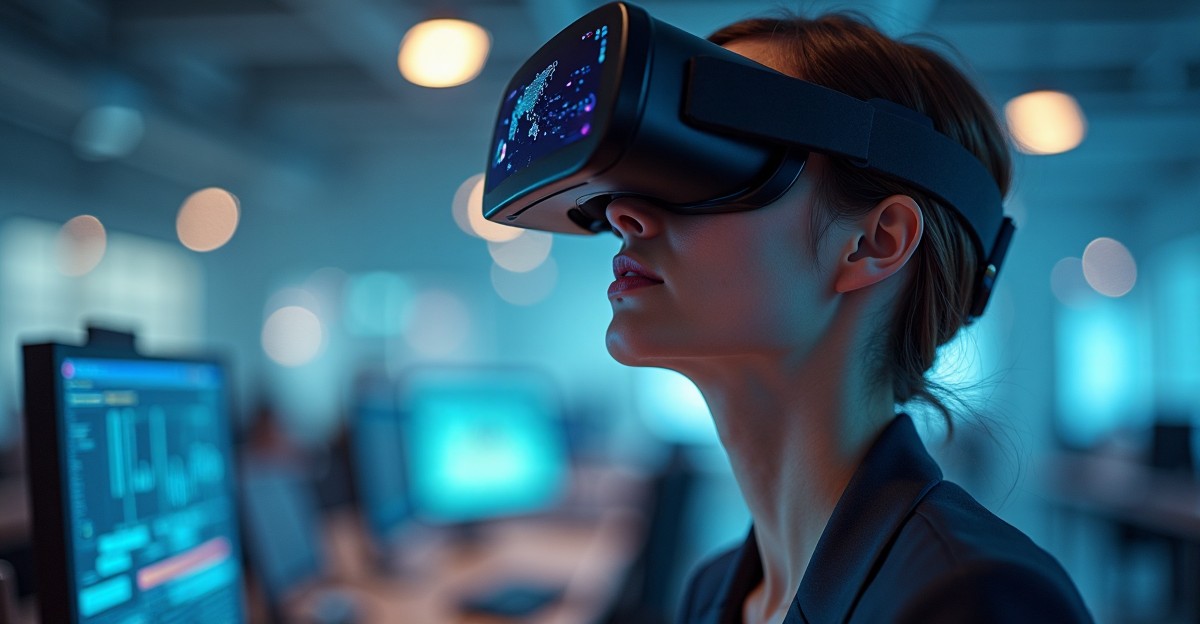Imagine this: your newest engineer walks into a job site wearing lightweight AR glasses that instantly overlay 3D blueprints onto real-world equipment. Meanwhile, your remote team in Singapore collaborates with headquarters in a holographic meeting that feels just as effective as being in the same room. This isn’t a future dream; it’s the present reality for forward-thinking companies embracing spatial computing.
As an innovation leader or HR executive, you’re always exploring ways to boost productivity, enhance training, and attract top-tier talent. The convergence of augmented reality (AR), virtual reality (VR), and AI into a single, immersive framework—spatial computing—presents a game-changing opportunity to transform how your organization operates.
Yet despite high interest, many companies face two major roadblocks:
-
Defining real-world applications that deliver ROI.
-
Finding the specialized talent to bring these applications to life.
Beyond the Hype: Real Business Use Cases Already Delivering Results
Spatial computing isn’t just a flashy trend; it’s a powerful tool being deployed across industries today. Enterprises are already seeing tangible gains in three primary areas:
Virtual Onboarding & Training
-
New hires complete equipment or safety training in fully immersive environments—no risk, no downtime.
-
Sales reps practice real-life scenarios using AI-driven simulations.
-
Technicians gain confidence by mastering complex procedures in VR before ever handling live equipment.
Enhanced Remote Collaboration
-
Teams worldwide interact with 3D models in real-time, regardless of location.
-
Engineers troubleshoot field equipment via AR-assisted live video.
-
Designers iterate on products in shared virtual workspaces, speeding up time-to-market.
Real-Time Performance Support
-
Field techs receive step-by-step AR instructions overlaid directly on machinery.
-
Customer service teams instantly access product specs in immersive dashboards.
-
Warehouse staff optimize routes using spatial navigation overlays.
These aren’t isolated pilot programs, they’re scalable, integrated tools driving efficiency, consistency, and innovation at the enterprise level.
The Overlooked Advantage: Reducing Cognitive Load
While spatial computing is often praised for its cutting-edge hardware and immersive experiences, its most powerful impact may be how it enhances human performance by reducing cognitive load. Traditional onboarding tools like manuals and videos are quickly becoming obsolete. With spatial computing, new employees can engage in interactive, hands-on training that replicates real-world scenarios—dramatically improving skill acquisition and reducing onboarding time by as much as 70%.
Beyond training, spatial computing minimizes errors and boosts productivity by replacing guesswork with guided, step-by-step AR instructions. This clarity significantly reduces the chances of mistakes, especially in complex procedures. For leadership teams, immersive 3D data visualizations empower faster, more informed decision-making by presenting information in a format that reveals patterns and insights traditional dashboards might miss. And from a workforce perspective, AR and VR technologies resonate deeply with Millennial and Gen Z professionals. These tools not only align with their tech-savvy expectations but also contribute to higher engagement and job satisfaction—making your organization more attractive to top-tier talent.
How to Build a Winning Spatial Computing Strategy
Success doesn’t come from buying the latest VR headset, it requires thoughtful planning and the right team. Here’s how innovative companies are getting it right:
1. Identify High-Impact Use Cases
Focus on areas where immersive experiences solve real problems:
-
Dangerous or complex training
-
Multi-site collaboration
-
Process optimization
-
Customer experience upgrades
2. Start Small, Prove Value
Pilot a focused initiative:
-
Choose one department or challenge
-
Set measurable goals (time saved, errors reduced, employee feedback)
-
Scale only after proving ROI
3. Invest in the Right Talent
Technology is only as powerful as the team behind it. You’ll need:
-
3D Modelers and UX Designers to craft intuitive environments
-
AR/VR Developers skilled in platforms like Unity or Unreal Engine
-
Systems Integrators to connect immersive tools with existing IT infrastructure
-
Change Managers to guide adoption and ensure ROI
4. Build a Governance Framework
Lay down operational standards:
-
Data privacy and compliance in virtual spaces
-
Hardware lifecycle management
-
Security and access control for spatial systems
-
Ongoing performance measurement
Common Challenges and How to Tackle Them
Even with a strong spatial computing strategy, implementation can present several challenges, but with the right approach, they’re entirely manageable. One of the most common hurdles is technology integration. AR and VR solutions must work seamlessly with your existing systems, which means prioritizing platforms with open APIs and robust enterprise support. Without smooth integration, even the most advanced tools can become operational roadblocks.
User adoption is another critical factor. New technology can be intimidating, especially for teams unfamiliar with immersive environments. Encouraging adoption requires visible support from leadership, engaging and gamified training experiences, and clear communication about how these tools benefit both individual roles and overall business goals.
Content creation has traditionally been a bottleneck, often requiring highly specialized technical skills. Fortunately, the rise of no-code and low-code AR/VR platforms now empowers internal subject matter experts to develop immersive content without needing to write a single line of code. Finally, justifying ROI is essential. While hard metrics like reduced training time and lower error rates are important, soft benefits, such as improved employee engagement and a stronger culture of innovation, are equally valuable. When executed well, spatial computing initiatives often pay for themselves within 6 to 18 months.
Your Competitive Advantage Starts With the Right Talent
The biggest barrier to spatial computing isn’t hardware, it’s hiring. The demand for professionals who can design, build, and support AR/VR environments is growing fast. Yet most companies lack the internal expertise to identify and recruit the right candidates.
That’s where GTN Technical Staffing comes in. We specialize in connecting organizations with top-tier AR/VR and spatial computing talent. Whether you’re launching your first pilot or scaling enterprise-wide programs, we’ll help you:
-
Find proven professionals with relevant experience
-
Assess technical skills in Unity, Unreal Engine, and immersive design
-
Build balanced teams of creatives, engineers, and integrators
-
Scale your workforce as your strategy evolves
Spatial computing isn’t just the next big thing, it’s the new normal. Organizations that embrace AR and VR today will lead in productivity, innovation, and talent acquisition tomorrow. Don’t get left behind. GTN Technical Staffing can help you build the specialized team that brings your spatial computing vision to life. Contact GTN today and start shaping the future of work.





